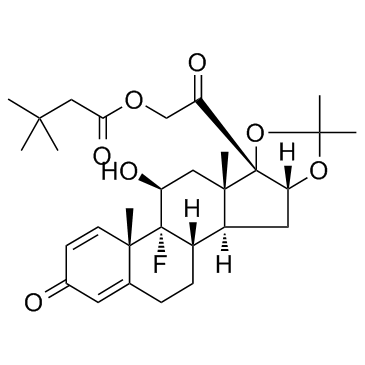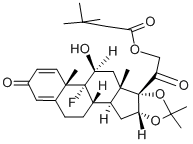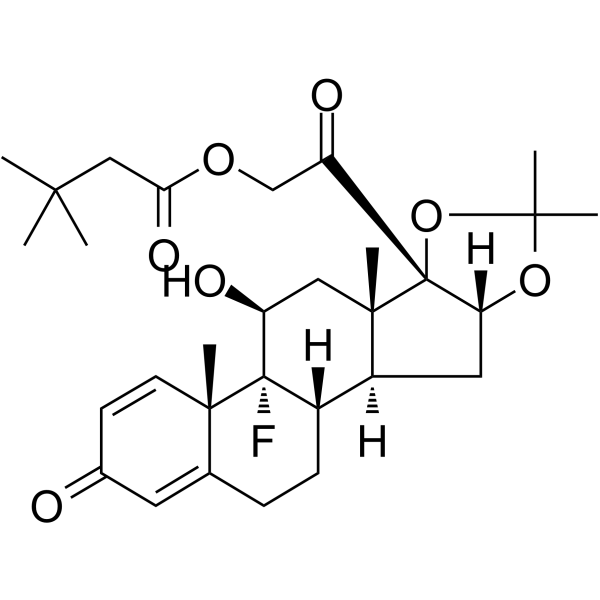Triamcinolone hexacetonide 己曲安奈德,98.02%
产品编号:Bellancom-U00103| CAS NO:5611-51-8| 分子式:C30H41FO7| 分子量:532.64
Triamcinolone hexacetonide是一种常用的长效类固醇,用于治疗亚急性和慢性炎性关节疾病。
本网站销售的所有产品仅用于工业应用或者科学研究等非医疗目的,不可用于人类或动物的临床诊断或者治疗,非药用,非食用,
Triamcinolone hexacetonide 己曲安奈德
| 产品介绍 | Triamcinolone hexacetonide 是一种常用的长效类固醇,有潜力用于亚急性和慢性炎性关节疾病的研究。 | ||||||||||||||||
|---|---|---|---|---|---|---|---|---|---|---|---|---|---|---|---|---|---|
| 生物活性 | Triamcinolone hexacetonide is a commonly used long-acting steroids in treatment of subacute and chronic inflammatory joint diseases. | ||||||||||||||||
| 体外研究 | |||||||||||||||||
| 体内研究 |
Triamcinolone hexacetonide produces a marked, dose-dependent protective effect in the model of chemically induced articular cartilage damage. Guinea pig injected with Triamcinolone hexacetonide shows much less prominent fibrillation and osteophytes. Cell loss is less extensive. A single injection of Triamcinolone hexacetonide into the ipsilateral knee of rabbits which have been subjected to partial lateral meniscectomy and transection of the sesamoid and collateral fibular ligaments reduces chondrocyte cloning, loss of cells, osteophyte formation, and fibrillation. The half-life of commercially available Triamcinolone hexacetonide in the vitreous is double that of Triamcinolone hexacetonide, but the former is toxic to the retina in this rabbit model. Reformulated iso-osmolar Triamcinolone hexacetonide shows no evidence of deleterious effects to retina function or structure. Local application of Triamcinolone hexacetonide at a site of lingual nerve injury leads to changes that are potentially beneficial such as reduced mechanical sensitivity and enhanced regeneration. 西域 has not independently confirmed the accuracy of these methods. They are for reference only. | ||||||||||||||||
| 体内研究 |
Triamcinolone hexacetonide produces a marked, dose-dependent protective effect in the model of chemically induced articular cartilage damage. Guinea pig injected with Triamcinolone hexacetonide shows much less prominent fibrillation and osteophytes. Cell loss is less extensive. A single injection of Triamcinolone hexacetonide into the ipsilateral knee of rabbits which have been subjected to partial lateral meniscectomy and transection of the sesamoid and collateral fibular ligaments reduces chondrocyte cloning, loss of cells, osteophyte formation, and fibrillation. The half-life of commercially available Triamcinolone hexacetonide in the vitreous is double that of Triamcinolone hexacetonide, but the former is toxic to the retina in this rabbit model. Reformulated iso-osmolar Triamcinolone hexacetonide shows no evidence of deleterious effects to retina function or structure. Local application of Triamcinolone hexacetonide at a site of lingual nerve injury leads to changes that are potentially beneficial such as reduced mechanical sensitivity and enhanced regeneration. 西域 has not independently confirmed the accuracy of these methods. They are for reference only. | ||||||||||||||||
| 性状 | Solid | ||||||||||||||||
| 溶解性数据 |
In Vitro:
DMSO : 41.67 mg/mL (78.23 mM; Need ultrasonic) 配制储备液
*
请根据产品在不同溶剂中的溶解度选择合适的溶剂配制储备液;一旦配成溶液,请分装保存,避免反复冻融造成的产品失效。 In Vivo:
请根据您的实验动物和给药方式选择适当的溶解方案。以下溶解方案都请先按照 In Vitro 方式配制澄清的储备液,再依次添加助溶剂:
——为保证实验结果的可靠性,澄清的储备液可以根据储存条件,适当保存;体内实验的工作液,建议您现用现配,当天使用;
以下溶剂前显示的百
*以上所有助溶剂都可在 西域 网站选购。
| ||||||||||||||||
| 运输条件 | Room temperature in continental US; may vary elsewhere. | ||||||||||||||||
| 储存方式 |
| ||||||||||||||||
| 参考文献 |
|
| 危险品运输编码 | NONH for all modes of transport |
|---|
|
Section 1. Chemical Product and Company Identification Triamcinolone Hexacetonide Common Name/ Trade Name Triamcinolone Hexacetonide Section 4. First Aid Measures Eye ContactCheck for and remove any contact lenses. In case of contact, immediately flush eyes with plenty of water for at
least 15 minutes. Get medical attention if irritation occurs. Skin ContactWash with soap and water. Cover the irritated skin with an emollient. Get medical attention if irritation develops. Serious Skin ContactNot available. InhalationIf inhaled, remove to fresh air. If not breathing, give artificial respiration. If breathing is difficult, give oxygen. Get medical attention. Serious InhalationNot available. IngestionDo NOT induce vomiting unless directed to do so by medical personnel. Never give anything by mouth to an unconscious person. If large quantities of this material are swallowed, call a physician immediately. Loosen tight clothing such as a collar, tie, belt or waistband. Serious IngestionNot available. Section 5. Fire and Explosion Data Flammability of the Product May be combustible at high temperature. Auto-Ignition Temperature Not available. Flash PointsNot available. Flammable LimitsNot available. Products of CombustionThese products are carbon oxides (CO, CO2), halogenated compounds. Fire Hazards in Presence of Slightly flammable to flammable in presence of heat. Various SubstancesNon-flammable in presence of shocks. Explosion Hazards in Presence Slightly explosive in presence of open flames and sparks. Non-explosive in presence of shocks. of Various Substances SMALL FIRE: Use DRY chemical powder. Fire Fighting Media and InstructionsLARGE FIRE: Use water spray, fog or foam. Do not use water jet. As with most organic solids, fire is possible at elevated temperatures Special Remarks on Fire Hazards Special Remarks on Explosion Fine dust dispersed in air in sufficient concentrations, and in the presences of an ignition source is a potential dust Hazardsexplosion hazard. Section 6. Accidental Release Measures Small SpillUse appropriate tools to put the spilled solid in a convenient waste disposal container. Finish cleaning by spreading water on the contaminated surface and dispose of according to local and regional authority requirements. Large SpillUse a shovel to put the material into a convenient waste disposal container. Finish cleaning by spreading water on the contaminated surface and allow to evacuate through the sanitary system. Triamcinolone Hexacetonide Section 7. Handling and Storage PrecautionsKeep away from heat. Keep away from sources of ignition. Do not breathe dust. StorageKeep container tightly closed. Keep container in a cool, well-ventilated area. Section 8. Exposure Controls/Personal Protection Engineering ControlsUse process enclosures, local exhaust ventilation, or other engineering controls to keep airborne levels below recommended exposure limits. If user operations generate dust, fume or mist, use ventilation to keep exposure to airborne contaminants below the exposure limit. Personal ProtectionSafety glasses. Lab coat. Dust respirator. Be sure to use an approved/certified respirator or equivalent. Gloves. Personal Protection in Case of Splash goggles. Full suit. Dust respirator. Boots. Gloves. A self contained breathing apparatus should be used a Large Spillto avoid inhalation of the product. Suggested protective clothing might not be sufficient; consult a specialist BEFORE handling this product. Exposure LimitsNot available. Section 9. Physical and Chemical Properties Physical state and appearance Solid. (Crystalline powder.)OdorOdorless. TasteNot available. Molecular Weight532.64 g/mole White. Off-white. Color Not available. pH (1% soln/water) Boiling PointNot available. Decomposition temperature: 295°C (563°F) Melting Point Critical TemperatureNot available. Specific GravityNot available. Vapor PressureNot applicable. Vapor DensityNot available. VolatilityNot available. Odor ThresholdNot available. Not available. Water/Oil Dist. Coeff. Ionicity (in Water)Not available. Dispersion PropertiesNot available. SolubilityInsoluble in cold water, hot water. Section 10. Stability and Reactivity Data StabilityThe product is stable. Not available. Instability Temperature Conditions of InstabilityNot available. Incompatibility with variousNot available. substances CorrosivityNot available. Triamcinolone Hexacetonide Not available. Special Remarks on Reactivity Not available. Special Remarks on Corrosivity PolymerizationWill not occur. Section 11. Toxicological Information Routes of EntryInhalation. Ingestion. Toxicity to AnimalsLD50: Not available. LC50: Not available. Chronic Effects on Humans Not available. Other Toxic Effects on Slightly hazardous in case of skin contact (irritant), of ingestion, of inhalation. Humans Special Remarks onNot available. Toxicity to Animals Special Remarks onMay cause adverse reproductive effects and birth defects (teratogenic) Human: passes through the placenta. Chronic Effects on Humans Special Remarks on otherPotential Health Effects: Toxic Effects on HumansSkin: May cause skin irritation. Eyes: May cause eye irritation. Inhalation: May cause respiratory tract irritaition. Ingestion: May cause gastrointestinal tract irritation with abdominal distension, nausea, vomiting. May cause ulcerative esophagitis and peptic ulcers. May cause fluid and electrolyte disturbances resulting in sodium retention, fluid retention, congestive heart failure in susceptible individuals, potassium loss, hypokalemic alkalosis, increased calcium excretion, mild diuresis, polyuria, polydypsia, hypertension. May cause depression of appetite/anorexia in contrast to voracious appetite ordinarily encountered with other glucocorticoids. Common corticosteroids may cause euphoria whereas Triamcinolone may cause mood depression. May cause steroid myopathy/muscular atrophy with loss of muscle mass and muscle weakness involving muscles of the thighs, pelvis, and low back, muscle cramps. May cause other musculoskeletal effects such as Osteoporosis, vertebral conpression fractures, pathologic fractures of long bones. May affect immune system/immune response and increase the susceptibly to infections. May very rarely cause hypertension, hyperglycemia, and may affect behavior/central nervous system (excitation, vertigo, headache, convulsions, psychosis, hallucinations), and eye problems (glaucoma, mydriasis). Dermatologic effects may include impaired wound healing, thin fragile skin, facial erythema, petechiae and ecchymoses. Section 12. Ecological Information Not available. Ecotoxicity BOD5 and CODNot available. Products of BiodegradationPossibly hazardous short term degradation products are not likely. However, long term degradation products may arise. The products of degradation are more toxic than the product itself. Toxicity of the Products of Biodegradation Special Remarks on theNot available. Products of Biodegradation Triamcinolone Hexacetonide Section 13. Disposal Considerations Waste DisposalWaste must be disposed of in accordance with federal, state and local environmental control regulations. Section 14. Transport Information DOT ClassificationNot a DOT controlled material (United States). Not applicable. Identification Not applicable. Special Provisions for Transport DOT (Pictograms) Section 15. Other Regulatory Information and Pictograms No products were found. Federal and State Regulations CaliforniaCalifornia prop. 65: This product contains the following ingredients for which the State of California has found to cause cancer which would require a warning under the statute: No products were found. Proposition 65 Warnings California prop. 65: This product contains the following ingredients for which the State of California has found to cause birth defects which would require a warning under the statute: No products were found. Other RegulationsEINECS: This product is on the European Inventory of Existing Commercial Chemical Substances. Other ClassificationsWHMIS (Canada) Not controlled under WHMIS (Canada). DSCL (EEC)This product is not classified according Not applicable. to the EU regulations. Health Hazard HMIS (U.S.A.)1 National Fire Protection 1 Flammability 1 Association (U.S.A.) Fire Hazard 1 0 Reactivity Health Reactivity 0 Specific hazard Personal Protection E WHMIS (Canada) (Pictograms) DSCL (Europe) (Pictograms) TDG (Canada) (Pictograms) Triamcinolone Hexacetonide ADR (Europe) (Pictograms) Protective Equipment Gloves. Lab coat. Dust respirator. Be sure to use an approved/certified respirator or equivalent. SECTION 16 - ADDITIONAL INFORMATION N/A |
 有竞争力的价格
有竞争力的价格匹配竞争对手的价格
 极速物流
极速物流效率为先
 技术支持
技术支持专业经验 贴心服务
 现货库存
现货库存50000+库存





 浙公网安备 33010802013016号
浙公网安备 33010802013016号